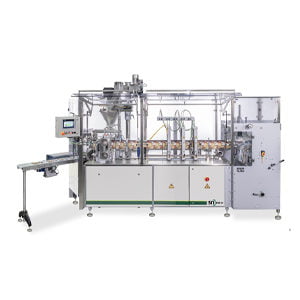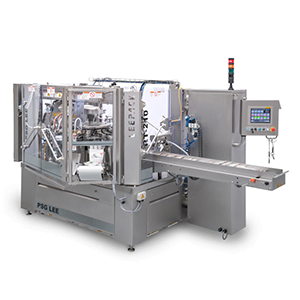
A Guide to Automated Bagging Machines
Bagging machines play a crucial role in various industries by automating the packaging process and ensuring efficient and accurate product packaging. From food and pharmaceuticals to industrial and consumer goods, automated bagging machines have revolutionized the way products are packaged and prepared for distribution. In this article, we will delve into the world of bagging machines, exploring their types, working mechanisms, and the benefits they offer to businesses.
What is Automated Bagging?
Automated bagging, represents a transformative packaging methodology that embraces minimal manual involvement. Bagging machines are meticulously designed to orchestrate precision and efficiency. These machines possess the remarkable ability to either craft flexible packaging material into bespoke forms or harness pre-made pouches and bags, catering to a myriad of packaging needs.
The pursuit of accuracy is the very heart of the automated bagging process and this accuracy extends to both product weight and the uniformity of fill levels. In essence, manufacturers are afforded an unprecedented degree of control over product loss and giveaway.
Sealing is also a key component contributing to packaging excellence. The sealing process is sometimes accompanied by the injection of inert gas to eliminate the presence of oxygen in the packaging. When oxygen is present in a sealed package, it can initiate chemical reactions and biological processes that contribute to product degradation. By removing oxygen, these detrimental processes are impeded, leading to prolonged product freshness and quality. An impenetrable seal not only safeguards the product’s freshness but also erects an barrier against contamination.
Additional functionalities like labeling and coding are often included in bagging systems and provide essential product information and traceability. These details not only cater to regulatory needs but also provides consumers with the reassurance of a quality product which is meticulously monitored from the time it leaves the production facility to the moment it comes to them.
In essence, automated bagging merges mechanized precision with human ingenuity, elevating packaging into a narrative of innovation and care. Each product becomes a testament to quality, guided from creation to consumption by the commitment to excellence inherent in automated bagging.
Types of Automated Bagging Machines
Automated bagging machines have transformed the packaging landscape, offering a range of automated solutions that cater to diverse industries and packaging requirements. From liquids and powders to granulated substances, these machines come with specific features and functionalities that are tailored to the unique demands of each application. In this section, we will explore the intricacies of different types of automated bagging machines, delving into their specificities and explaining why they excel in distinct packaging scenarios.
HFFS Bagging Machines
Horizontal Form-Fill-Seal (HFFS) machines represent a significant leap in packaging technology, enabling streamlined and efficient packaging processes across a range of industries. These machines have gained popularity due to their ability to automate the entire packaging workflow—from forming the packaging material to filling it with the product and sealing it in a single continuous operation.
The operation of an HFFS machine can be broken down into several key steps:
- Material Unwinding: The packaging material—often a roll of flexible film—is unwound and fed into the machine which operates on a horizontal layout.
- Forming: The machine forms the packaging material into a desired shape, such as a pouch or bag. This can be accomplished using forming tubes, collars, or other mechanisms.
- Product Dispensing: The product to be packaged is accurately dispensed into the formed pouch. This step can involve various measuring systems to ensure precise fill levels.
- Sealing: The open end of the pouch is sealed, creating a secure and tamper-resistant package. Different sealing methods, such as heat sealing or ultrasonic sealing, may be employed depending on the packaging material and product.
- Cutting and Ejection: Once the pouch is sealed, it is cut and separated from the rest of the packaging material. The finished pouch is then ejected from the machine, ready for further processing or distribution.
VFFS Bagging Machines
Vertical Form-Fill-Seal (VFFS) have the ability to accommodate various product types, from granulated substances and powders to liquids and snacks. Their adaptability extends to different packaging materials, including flexible films and laminates. This makes VFFS machines an indispensable asset for industries that span from food and beverages to pharmaceuticals and beyond. They also maximize space utilization, making them a prime choice for businesses aiming to balance versatility and spatial constraints.
The operation of a VFFS machine can be broken down into several key steps:
1. Film Unwind and Forming: The process commences as the packaging material, usually a roll of flexible film, is unwound from its reel. The film passes vertically through various mechanisms that guide it into the desired form for the packaging—typically, a tube-like shape. The film’s edges are sealed longitudinally to create a continuous tube.
2. Product Filling: As the continuous tube of film progresses, the product to be packaged is accurately dispensed into the forming tube. This can be accomplished using various filling mechanisms, such as augers, volumetric fillers, or liquid piston fillers. The precision of the filling mechanism ensures consistent product quantities in each package.
3. Sealing and Cutting: Once the product is properly filled within the forming tube, the machine engages in the sealing process. Transverse sealing jaws are utilized to create a seal between the layers of the film, effectively enclosing the product within the pouch or bag. Simultaneously, the film is cut horizontally, creating separate pouches or bags.
4. Product Discharge: Following the sealing and cutting phase, the individual pouches or bags are separated from the continuous film. Depending on the machine’s configuration, the pouches may be transferred to a conveyor belt or other mechanism for further processing.
5. Quality Control and Inspection: HFFS machines often include quality control mechanisms to ensure that each package meets the required standards. These mechanisms can involve sensors that detect proper seal integrity, fill levels, and other aspects critical to the packaging’s quality.
6. Secondary Operations (Optional): Depending on the specific requirements of the product and packaging, VFFS machines may incorporate additional steps. These could include adding a zipper, applying labels and coding, or even incorporating gas flushing in modified atmosphere packaging (MAP) applications.
FFS Bagging Machines
Form-Fill-Seal (FFS) machines stand as one of the cornerstones of modern packaging technology, offering an integrated approach to creating, filling, and sealing larger sized bags. As seen above the FFS family includes the Horizontal and vertical orientations for smaller pouch sizes. FFS also includes models specialized for larger bags ranging anywhere from 5 – 50 kg. Despite their compact footprint, FFS machines are engineered to deliver high-capacity outputs, making them ideal for companies aiming to meet demanding production requirements without compromising on space efficiency.
The operation of an FFS machine is a carefully choreographed sequence that involves multiple steps:
- Forming: The machine unwinds the packaging material. The material is shaped into the desired packaging format, which can be pouches, bags, or other customized forms.
- Filling: The product to be packaged is accurately dispensed into the formed packaging material. This step ensures consistent fill levels and minimizes waste.
- Sealing: The packaging material is sealed to enclose the product securely. Various sealing methods, such as heat sealing or ultrasonic sealing, can be employed based on the packaging material and the product’s requirements.
- Cutting: The sealed packages are separated from the continuous material, creating individual units ready for distribution.
FS Bagging Machines for Pre-Made Pouches
Fill & Seal Pre-Made Pouch Baggers excel in their ability to efficiently and accurately package a wide range of products, from liquids to dry or frozen goods, into stand-up pouches with zippers or corner spouts, depending on the chosen configuration. Their ability to accommodate a variety of products in stand-up pouches with specialized features positions them as a packaging game-changer, particularly within the food industry where adaptability, efficiency, and consumer appeal are paramount.
The operation of an FFS machine is a carefully choreographed sequence that involves multiple steps:
- Pouch Loading: The pre-formed pouches are loaded into the machine’s filling station. These pouches come equipped with zippers or corner spouts, ready to be filled.
- Product Dispensing: The desired product, whether liquid, dry, or frozen, is accurately dispensed into the pouch. Sophisticated measuring and dosing systems ensure consistent filling levels.
- Sealing and Closure: Once the pouch is filled, the machine engages in the sealing process. If equipped with zippers or corner spouts, the machine ensures that these features are integrated seamlessly while maintaining the integrity of the pouch’s contents.
- Quality Control: Modern baggers incorporate quality control mechanisms to detect any irregularities in sealing, filling accuracy, or pouch integrity.
- Ejection and Output: The finished pouches are ejected from the machine’s packaging station, ready for further processing, labeling, and distribution.
Working Mechanism of Automated Bagging Machines
Automated bagging machines epitomize the fusion of technology and efficiency, transforming the packaging landscape in various industries. Their operation revolves around a finely tuned process that not only optimizes production but also addresses challenges faced by Consumer Packaged Goods (CPG) manufacturing facilities, particularly those grappling with the shortage of qualified manual labor. As industries continue to evolve, these machines remain a pivotal force, shaping the future of packaging and manufacturing.

Precision in Diversity
The world of automated bagging machines unfolds as a spectrum of specialized solutions, each catering to unique packaging needs. Whether it’s the adaptability of HFFS and VFFS machines, the efficiency of the Form-Fill-Seal Baggers for larger bags, or the specialized regular & spouted pouch handling of Pre-Made Pouch Baggers, they can optimize packaging processes, address labor challenges, and enhance efficiency on the production floor. Automated bagging is an invaluable asset to nearly any CPG manufacturing facility.
Ask our experts to identify the ideal bagging machine model for your project
Other Related Blogs
6 Key Factors to Consider when Buying a Pre-Made Pouch Bagger
Modern Pre-Made Pouch Baggers are growing in popularity with brand owners and retailers ov...
A Guide to Automated Bagging Machines
in Bagging, OptimizationDive into the realm of automated bagging machines! Discover the most common bagging soluti...
A Guide to Flexible Packaging for Liquids
Discover the benefits of flexible pouches for liquid packaging and how they can transform ...








